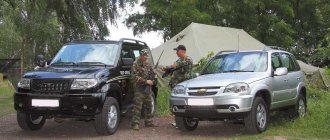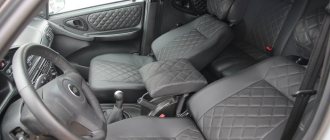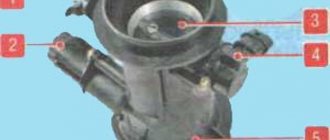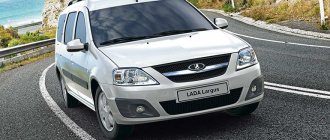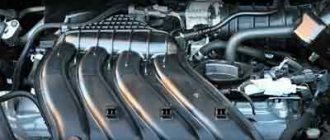Largus or Patriot?
What to prefer?
Tasks: — transportation around the city for a team of 4-5 people. with tools - occasionally towing a trailer around the city and on the coast - transporting ladders and pipes on the roof - delivering small orders and samples to clients and retail outlets - once a month trip to Moscow, possibly with a trailer Largus: - larger trunk, but the interior is to put it mildly strange - good transformation of the interior - terrible ergonomics, frog design inside - no multimedia and installation is a pain - the design looks nothing from the outside - normal consumption - terribly durable, cheap repairs and maintenance
Patriot: - more powerful engine - more spacious - normal interior, good front panel layout, normal. multimedia - in winter sometimes you need plug-in all-wheel drive and locking - eats a lot - torn??
The trailer is a good two-axle Tonar (we load a ton with the Gazelle), but loading on intercity routes is only possible according to traffic regulations
On the back bench it’s generally tough, only in the city and for short distances. In general, this is also characteristic of larger pickup trucks of famous brands, even in the Tundra
Largus is the leader in its segment in terms of interior and trunk volume
useful volume is less than Patriot and Largus. And this is already a foreign car in service
I don’t want a gazelle, that’s enough
6-Half-Wild Cat >Amarok, Navara, L200, Ranger - in the back it’s like a stool, the seats are almost vertical, there’s not much legroom
7-Half-Wild Cat > of course. I just don’t like everything about Largus, and I don’t like some things about Patriot. I don't want a bus-truck
30-Headliner >when I worked in Stavropol, we had one like this. even the color is the same. sold quickly, because it was impractical and hemorrhoids (the chassis is all from the Niva, but it is already liquid, and here the loads are higher - both due to the empty mass and due to provoking additional loading). Nivovskie shock absorbers generally didn’t work well on it, they were changed twice a year until they started installing imported ones, crosspieces - the same song, once they bent the shaft, turned over half the city (although they did the repair work themselves) until they found it. in Stavropol, 4x4 is justified by the presence of the Komsomolskaya Hill and the famous climbs, but here there is no need for a PP. unnecessary waste of gasoline 10 months a year. It’s better to use this money to buy normal winter tires with studs, and not grind the roll with blocked wheels in universal tires when braking. As for ergonomics, not everyone can make it to Krasnodar without back pain. the field in this matter is still a ruin.
32-Headliner >that’s the Niva’s engine. to put it mildly, an unsuccessful design from an even more unsuccessful FIAT developed in the 1940s (in her teens it still had a lower camshaft with pushers). - look on the websites of banks (section “sale of mortgaged property”) and on bankrupt Largus, if you can get it for 30-50 thousand cheaper - go for a drive, try it and if you don’t like it - push it for the same money, and if in the spring (to the beginning season) - then you’ll also get rich.
You won’t be transporting panels, right? and hard workers, tools, varnish, consumables. Accordingly, the vehicle does not require a tonne capacity, and consumption, winter tires and maintenance are several times cheaper. and what comes as a pleasant bonus is that Largus on the secondary market is much more expensive than Patriot. for profit brings, and does not devour. and in terms of transport tax and insurance - much cheaper. as usual, set your priorities, universalism is a very expensive and inconvenient thing in practice.
Engines
As for motors, the differences with them are significant. The models are similar in that their engine capacity has few cubic meters. Plus it's about the same. The difference is only a couple of cubic centimeters. Approximately, the volume is 1.6 liters, which is not that much, but taking into account the budget, it is quite expected and acceptable.
But in terms of power, the Duster is significantly superior to its competitor, because it is capable of demonstrating all 114 horsepower at the peak of its capabilities. Is this too much? No, and again no, and to be convinced of this, just look at the characteristics of the top representatives of the SUV or station wagon class, where even 300 horsepower is by no means the limit.
That is why the fact that the Lada has only 87 horsepower makes the Duster much more interesting for those who are interested in dynamic performance rather than some other features of the car. In this case, the difference of almost 30 horsepower will play a significant role in how these two vehicles perform on the road.
As for the torque, the Renault Duster has 156 Newtons per meter at 4000 rpm, while the Lada has only 140 Newtons per meter at 3800 rpm, which, however, is also not bad. It turns out that the engines of the cars, although they are not too different, the Duster version is still more suitable for off-road driving, while the Largus Cross is unlikely to cope with a really serious cross-country race.
New Lada Largus or a used foreign car - recommendations from ZR
In the fall, AVTOVAZ finally abandoned Renault engines - Largus station wagons are now equipped exclusively with Volga engines. Prices, however, remained the same. However, Largus occupies an advantageous position in its segment. Consider that there are no competitors - among the new cars, the only thing that can compete with Largus is the Chinese Lifan Myway. Or maybe used foreign cars? We looked at all the options and this is what we came up with.
LADA > Largus
The reason for the popularity of Largus on the surface is the moderate price for a lot of car. No one else can offer such a combination on the market. A seven-seat modification with an eight-valve 87-horsepower engine in the Norma version costs from 605,900 rubles. The basic equipment includes ABS, driver's airbag, power steering, central locking, front electric windows, heated seats and even air conditioning. The minimum price for the 106-horsepower 16-valve version is 642,400 rubles.
However, the advantages of Largus lie not only in accessibility. In fact, it is very good in terms of practicality. It has a spacious not only second, but also third row, which is the exception rather than the rule in this segment. If necessary, the rear seats can be removed from the cabin, turning the trunk into a storage room. The suspension is also good. It provides excellent smoothness and energy efficiency - in our operating conditions this is difficult to underestimate.
But Largus also has disadvantages. For example, the lack of an automatic transmission. Many people are put off by the simple interior. And the appearance is also not so great - it’s difficult to call this car beautiful.
Test Lada Largus Cross as a truck
The distance between the axles of 2905 mm allows you to comfortably sit on the second row of seats or load large loads on the roof, fortunately Largus Cross is equipped with powerful roof rails.
Compared to Logan, the back seat is completely different. The enlarged base made it possible to move it forward and now passengers are not squeezed between the wheel arches. And thanks to the high roof, there is really a lot of space above your head, and there is even a storage compartment especially for rear passengers. So it’s a pleasure to go on a long journey with a large group in such a car. There will be room for everyone and plenty of space for luggage. The main thing is to be patient, as this trip will hardly be quick.
In the test configuration, you can sit in the third row. Moreover, even an adult can sit comfortably there. There is plenty of headroom and legroom, there are cup holders, and in addition the windows open slightly.
But the 7-seater version seemed like a mystery to us. Trunk volume is reduced to a ridiculous 136 liters, so this is only an option for a city taxi or to give colleagues a lift to the metro.
To get to the third row, you need to fold the second row of seats. This is done manually and in several steps. In addition, the reclined seat does not lock. Secondly, if the middle passenger sits on the second-row sofa, his seat belt coming out of the roof puts pressure on the third-row passengers’ necks, which is not comfortable.
This option is also possible when some of the seats are folded down, something long is riding in the cabin, for example, a windsurfing board, and passengers sit behind each other in three rows.
The trunk in the 5-seater version is simply huge - an honest 560 liters up to the level of the windows. If you fold the second row of seats, its volume increases to 2350 liters. It is also important that the luggage opening is designed for loading. The car received double-leaf doors to the compartment, opening both 90 and 180 degrees, and the opening itself was of a regular, square shape. The test Largus even fit a huge windsurfing board with a height of 264 cm.
Hinged doors are a real gift for those who like to fully load the car.
Still, our choice is the five-seater version. It is more practical because it can take five people on board along with their luggage; a seven-seater car will make you travel light. It’s interesting that you have to choose not between models, but between modifications. This once again proves that Largus essentially has no competitors in the category of inexpensive and spacious station wagon.
But excuse me, but what about the Vesta station wagon, is it not a competitor, you ask. In our opinion, no, Vesta is more modern and dynamic, and Largus is much more practical and knows how to jump through puddles.
From the author of the blog automps.ru Peter Menshikh: I thank Igor Sirin (co-author and presenter of the video), Evgeniy Mikhalkevich (cameraman, photographer), Roman Kharitonov (editor) for their participation in the preparation of the material.
Let me remind you that the video is a test of the Lada Largus Cross below, technical specifications are at the end of the article.
Chinese competitor
The only new classmate car that can be bought for money comparable to Largus is the newly debuted Lifan Myway
, which is sold for 799,900 rubles. Its notable features include rear-wheel drive. For Russia, this is a controversial decision. But the “Chinese” looks much nicer than the Lada. The interior is also good: modern architecture, rich equipment - you won’t have to pay extra for alloy wheels, ABS and ESP, two airbags, and a multimedia system with a touch screen. However, in terms of space, Lifan is inferior to Largus - the loss in the third row is especially noticeable. Myway is equipped with a non-alternative 1.8-liter 125-horsepower gasoline engine and a 5-speed manual transmission, which does not have very clear shifts.
Lada Largus Cross: a lot of space for little money
At the present time, a roomy station wagon with a price starting from 529,900 rubles looks like a very attractive offer. And even if the minimum stated price tag does not always have something in common with reality, the Lada Largus has been one of the strongest offers on the Russian car market in the category of inexpensive but spacious vehicles for several years now.
Buyers are offered two main options: an all-metal commercial van (from 469,900 rubles) and a passenger van with glazing (from 529,900 rubles). Each of them has several possible configurations.
This time we tested the pseudo-crossover version of Cross with the maximum level of equipment with seven seats for 699,000 thousand rubles. By the way, there is also a five-seater option. It is cheaper and costs 674,900 rubles.
The car is based on the B0 platform known to industry players. Its first-born was the previous generation Renault Logan, although today a lot of other models are built on it: Duster, X-ray, Sandero and, of course, Largus. The cart is simple and unpretentious, but reliable. In fact, Largus is the first generation Logan in a station wagon body. Moreover, this is not an invention of AvtoVAZ; passenger and commercial cars are also sold in Europe under the name of the Romanian brand Dacia Logan MCV. But the pseudo-crossover version of Cross was invented precisely in Togliatti at a time when Boo Andersson had just taken the helm of AvtoVAZ.
Secondary market
However, the light did not converge on these machines - you can turn your attention to the secondary market. For 600–700 thousand rubles it’s possible to pick up a five-year-old Citroen C4 Grand Picasso
with a mileage of about 100,000 km. This model features a stylish design and incredibly functional interior. So, there are four glove compartments on the front panel! The seats fold easily, allowing you to create a large, flat area in the cabin. And the equipment is what you need - most of the cars offered for sale have climate control, six airbags, and power accessories. The lion's share of cars on the market are equipped with a 1.6-liter 150-horsepower turbo engine and a robotic gearbox. Neither unit is highly reliable. It is better to pay attention to the version with a 1.6 diesel engine (109 hp), which in good hands lasts a long time.
UAZ Patriot - there is less and less Russian in it, but is it getting better?
Foreign companies are bending over backwards to increase the degree of localization of their Russian-assembled cars. And the UAZ Patriot is the opposite example: there is less and less Russian in it! Now a Dymos transfer case with electromechanical control has been added to the Korean gearbox - and... How much better has the “anti-localized” Patriot become?
Man, there is an effect! Less vibration, quieter hum. I drove the first lap on a dirt track near Ulyanovsk in a pre-reform Patriot: the gears howl, you need to apply truly masculine efforts to the transfer case control lever, the downshift is engaged only with the help of such and such a mother... And knocking out a gear in the transfer case has long become a family trait UAZ. This transmission comes from the sixties - a unit with gear transmission of torque to both axles first appeared on the UAZ-469. The only significant modernization occurred already in the 21st century, when instead of straight-cut gears, less noisy helical gears appeared.
And now - revolution! The gearbox of the Korean company Dymos was installed on the Patriot from the very beginning, and now UAZ has selected the same one from the assortment - almost the same one was used on the first generation Kia Sorento. For the UAZ, the unit had to be reworked and “packed” into a new crankcase: the driveshaft to the front wheels of Ulyanovsk cars goes to the right of the power unit, and not to the left, like the “Korean”. But the “dispensers” will be supplied not from Korea at all, but from China, where Dymos has its own plant.
The torque is transmitted to the front axle using a chain, so the Korean transfer case turned out to be noticeably larger than the domestic one and the floor panel had to be redone for it. The visible part of the iceberg is the new casing of the central tunnel in the cabin, on which there is a rotating control selector. There are, as before, three operating modes: rear-wheel drive (2H), all-wheel drive (4H) and all-wheel drive with low gear engaged (4L).
And no leverage! You can switch between rear-wheel drive and all-wheel drive while on the move, but turn on the range control only when the car is stationary, with the gearbox in neutral and the clutch pedal depressed. Then you need to turn the selector washer all the way to the right and hold it there for three seconds. I hold it, release it and... nothing happens - the “4H” icon is still lit in the instrument cluster. And only after another three seconds, when I reached for the selector again, it is replaced by the inscription “4L”. There is another unpleasant moment: if, during an off-road assault with the low gear engaged, the driver did not calculate the traction and turned off the engine, then after it starts, the transfer case automatically switches to 4H mode. In short, the UAZ team still needs to work on setting up the control electronics.
But with the new transfer case, the Patriot has become not only more comfortable, but also more passable: the range ratio has been increased by a third - from 1.94 to 2.56. But even here there is a fly in the ointment: the electronic unit and electric gearshift motor are installed outside, on the transfer case housing, and lack any protection - how long will they last when storming swamps, will they be able to withstand road chemicals? UAZ workers, of course, assure that there will be no problems, and proudly add that the interval between oil changes in the transfer case has been doubled - every 80 thousand kilometers.
By the way, the Patriot with its “native” transmission remains in the production program for now - this is the simplest Welcome package for 499 thousand rubles. Such cars are produced to order, the demand for them is small (only 30 SUVs were sold in three months), but UAZ still made a “production reserve” of three hundred pre-reform bodies.
Along with the Korean transfer case, the Patriot acquired other innovations. The power window buttons have moved to the door armrests, a new headliner has appeared, and the list of options now includes heated rear seats and a heated windshield. Alas, there are also simplifications: for example, the gas hood springs have disappeared - instead of them there is now an ordinary metal rod.
It’s good that the prices have not changed: from 568 thousand rubles for the Classic version with a gasoline engine to 755 thousand rubles for the diesel Patriot Limited. But even here, UAZ marketers resorted to a trick - the markup for all updates was included in the January price increase, and pre-reform Patriots now have a 15,000-dollar discount.
What's next? Already at the beginning of next year, UAZ promises to introduce cataphoresis technology for priming the bodies of the Patriot and Hunter instead of the ancient anaphoresis - this should significantly improve corrosion resistance. A little later, the technology for painting frames will also be changed.
At the same time, work is underway to improve the build quality and reduce the cost of UAZ vehicles. According to plant workers, huge resources for this are hidden in the optimization of logistics and production technology, because all this has been preserved since Soviet times, when UAZ worked primarily for the defense industry and no one really thought about efficiency. For example, some production is now being moved from the far corners of the plant closer to the assembly line in order to reduce the time and cost of delivering components, and the stamping and welding shops should become more compact.
Comparing Duster and Patriot, which is better to choose?
Viktor Samoilov asked the following question to the experts:
“Hello, I would like to ask a competent opinion on which is the best car to buy: a French-made Renault Duster or a Russian-made UAZ Patriot? In fact, what is best suited for driving not in urban conditions, but on serious off-road conditions. I know that the Patriot has already been tested by many car owners and people, and even by time, but the Duster that interests me is new and, in this regard, unknown.
In addition, you are interested in such aspects as the internal design and, accordingly, you are interested in the appearance of the car, characteristics, which of these cars has the cheapest repairs, some may have rare parts. In general, a comparison of these cars is welcome. What to choose to make it cheaper in terms of purchase, gasoline and repairs. Thanks for the advice!".
Ride quality, maneuverability and handling
Comparison of these characteristics when analyzing two cars is no less important than technical parameters. First of all, both models are designed to easily overcome off-road conditions, so you need to pay attention to their ground clearance level. Here, the Lada Niva Travel, which has a ground clearance of 220 mm, looks preferable. But for the UAZ Patriot this value is 210 mm. Considering the compactness and relative lightness of the body, the new product from AvtoVAZ looks more preferable.
If we talk about the handling and driving performance of the models, then both cars do not have outstanding characteristics and capabilities in this component. The Lada Niva Travel is characterized by an independent front suspension, built on double wishbones, as well as a dependent rear suspension, which is based on springs. In addition, the car is equipped with anti-roll bars, front disc brakes and rear drum mechanisms.
The UAZ Patriot relies on a fully dependent suspension. At the front it is represented by a spring base and anti-roll bar, and at the rear – an axle built on longitudinal springs. Despite the rather “ancient” version of the design, this solution is one of the most reliable in terms of the possibility of realizing the off-road capabilities of the car.
Vehicle specifications
If you compare two SUVs, their differences primarily lie in the actual dimensions of the body, as well as their weight. The Patriot is much larger and correspondingly heavier than its direct French competitor. Plus, the Russian car has a power plant with a much larger volume, respectively, than that of the “French”. Because of this, the power is greater, which indicates a large amount of fuel consumption while driving. Therefore, it is impossible to say unequivocally which is better.
Driving within the city
The ride on the UAZ Patriot is generally comfortable; at high speed it holds the road well and with high quality, and also when performing various maneuvers. Even so, its roll is very minimal. In turn, the gearbox of our car works well in all modes. Naturally, this is considered a good result, given the large size of the car and rear-wheel drive. This car's so-called braking distance is approximately the same as that of the Renault Duster, taking into account that the weight of the UAZ Patriot is greater and it does not have an ABS system.
If we compare handling and overall maneuverability, then, of course, the Frenchman wins in any case. It feels great in traffic because it is equipped with an all-wheel drive system, has compact dimensions compared to the UAZ, and, therefore, better maneuverability. The model's suspension also copes with its duties with a bang. All obstacles are overcome by the machine smoothly and smoothly. An important detail is that the acceleration time from zero to 100 km/h is shorter for Duster. He needs 1st speed only to carry out the “uphill start”. This is a powerful argument regarding what to choose.
